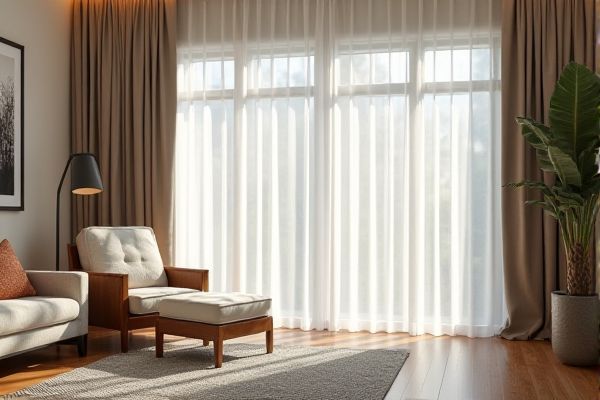
Drapery offers a soft, elegant look with fabric panels that provide insulation and light control, while blinds deliver a sleek, modern appearance with adjustable slats for precise light management and privacy. Discover how your choice between drapery and blinds can transform your home's ambiance by reading the rest of the article.
Table of Comparison
| Feature | Drapery | Blinds |
|---|---|---|
| Material | Fabric, often thick and heavy | Slats made of wood, metal, or plastic |
| Light Control | Moderate to full light blockage | Precise light regulation with adjustable slats |
| Privacy | High privacy when closed | Adjustable privacy depending on slat angle |
| Insulation | Excellent thermal insulation | Moderate insulation |
| Maintenance | Requires regular cleaning or dry cleaning | Easy to clean with dusting or wiping |
| Style | Elegant and traditional look | Modern and minimalistic appearance |
| Installation | Requires curtain rods or tracks | Mounted inside or outside window frame |
| Cost | Typically higher due to fabric and customization | Generally more affordable |
Introduction to Drapery and Blinds
Drapery consists of fabric panels that hang from a rod, providing softness, insulation, and decorative appeal, often crafted from materials like cotton, silk, or velvet. Blinds feature slats made of wood, metal, or plastic that can be tilted to control light and privacy, offering a modern and functional window covering solution. Both options vary in style, light control, and insulation properties, making them essential considerations for interior design and energy efficiency.
Aesthetic Differences: Drapery vs Blinds
Drapery offers a soft, textured aesthetic that enhances warmth and elegance in interior spaces, often made from fabrics like silk, linen, or velvet. Blinds provide a sleek, modern look with clean lines and precise control over light and privacy, commonly constructed from materials such as wood, aluminum, or PVC. The choice between drapery and blinds significantly impacts room ambiance, with drapery emphasizing softness and luxury while blinds emphasize minimalism and functionality.
Light Control Comparison
Drapery offers versatile light control through heavy fabrics that can block or filter sunlight, creating a cozy ambiance, while blinds provide precise adjustment with slats that tilt to regulate light intensity and direction effectively. Your choice depends on whether you prefer the softness and insulation benefits of drapery or the customizable light modulation and modern look of blinds. Both options can enhance privacy and energy efficiency, but blinds excel in fine-tuning natural light throughout the day.
Privacy Features of Drapery and Blinds
Drapery offers superior privacy by using thick, opaque fabrics that effectively block outside views and light, making it ideal for bedrooms or living areas needing confidentiality. Blinds provide adjustable privacy through slats that can be tilted to control visibility and light without fully closing the window covering. Your choice between drapery and blinds should consider how much control over privacy and light you need in each room.
Energy Efficiency: Which Is Better?
Blinds typically offer superior energy efficiency due to their adjustable slats, allowing precise control over sunlight and heat penetration, which helps maintain indoor temperatures and reduce HVAC costs. Drapery can provide effective insulation, especially when made from heavy or thermal-lined fabrics, but lacks the customizable light control of blinds. Energy savings depend on material quality and installation, with blinds often favored for year-round temperature regulation.
Maintenance and Durability
Drapery requires regular cleaning to prevent dust buildup and potential fabric wear, often needing professional dry cleaning to maintain durability. Blinds made from materials like aluminum or vinyl offer easier maintenance through simple dusting or wiping and tend to be more resistant to moisture and fading. While drapes provide a softer aesthetic, blinds usually deliver enhanced long-term durability with minimal upkeep.
Cost Analysis: Drapery vs Blinds
Drapery typically involves higher upfront costs due to fabric, customization, and installation expenses, whereas blinds are more budget-friendly with a wide range of affordable options. Maintenance and durability impact long-term costs where blinds may require replacement more frequently, while drapes often need cleaning but withstand wear better. Selecting between drapery and blinds depends on balancing initial investment against lifespan, style preferences, and functional needs.
Installation Process and Flexibility
Drapery installation involves mounting curtain rods or tracks above the window frame, requiring precise measurements and anchoring for full-length fabric panels. Blinds offer a more straightforward installation with bracket mounts inside or outside the window frame, often designed for easy DIY setup. Drapery provides greater flexibility in design and layering options, while blinds allow precise light control and space-saving functionality.
Best Applications for Each Option
Drapery excels in providing enhanced insulation and light control, making it ideal for living rooms and bedrooms where privacy and warmth are priorities. Blinds offer precise light adjustment and a streamlined look, suitable for offices, kitchens, and modern spaces that require easy maintenance and functionality. Both window treatments cater to different aesthetic and practical needs, with drapery favoring softness and blinds emphasizing versatility and minimalism.
Choosing the Right Window Treatment for Your Space
Drapery offers rich textures and insulation benefits, enhancing the warmth and style of your room, while blinds provide precise light control and a sleek, modern look ideal for minimalist spaces. Consider factors like privacy needs, natural light preferences, and room functionality to determine which window treatment best suits your lifestyle. Your choice ultimately influences ambiance, energy efficiency, and overall aesthetic harmony in the space.
 homyna.com
homyna.com